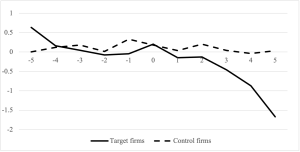The GameStop short squeeze at the beginning of 2021 has brought attention to a class of short sellers who launch high-profile public short campaigns (PSCs) to talk down a target firm’s stock. These activist short sellers, unlike traditional short sellers who often keep their short positions private, publicly denounce their targets and present evidence of specific allegations, such as accounting irregularities and product deficiencies, or they may simply allege that a target’s stock is overvalued.
The increasing prominence of these activist short sellers prompts debate on what roles they play in the financial market. Critics and, in particular, the management targeted by PSCs have accused these activists of manipulating markets, spreading falsehoods, and causing target companies long-term economic damage. For example, when several activist hedge funds announced their short positions in Tesla’s stock, Tesla CEO, Elon Musk, accused them of fabricating rumors, calling them “value destroyers” who distracted the company from long-term value creation.
Do PSCs really harm target firms? In a recent study, we seek to answer this question by examining whether PSCs affect important corporate innovation, using a novel dataset of new product and service announcements from Capital IQ’s Key Developments database. Even after accounting for the possibly superior stock-picking abilities of activist short sellers, we find that PSCs substantially reduce their targets’ new product introductions (NPI). Using a sample of 274 PSCs announced over the period 2010-2017 targeting firms headquartered in the United States, Figure 1 below demonstrates that target firms experience greater declines in the adjusted NPI per year (a firm’s annual NPI minus its average across all years) relative to control firms for up to five years following PSC announcements. Further, results from our difference-in-differences regressions show that, relative to their matched control firms, PSC target firms introduce 11.2 percent fewer new products per year, on average, after being targeted. The negative impact of PSCs lasts up to five years after the campaign announcement, indicating that the product market impact is not transitory. Furthermore, target firms experience long-term decreases in innovation productivity as well as product quality.
Figure 1. Target and control firms’ mean adjusted number of new product introductions surrounding public short campaign announcements by year relative to announcement of campaign
We find that the decline in product innovation is partly due to key stakeholders withdrawing their support from the target firm. The negative publicity surrounding target firms during the PSC adversely affects stakeholders’ perceptions of the target firm’s future products. We consider three types of key stakeholders in our analysis who are integral to the innovation process: capital providers, customers, and employees, and find that the negative product impact of PSCs is especially prominent among firms most vulnerable to declining support from these three types of stakeholders. Specifically, the decline in product innovation is especially strong among financially constrained firms and firms with weaker commitments from customers and employees. Additional results show that target firms reduce the capital they raise and have worse relationships with their customers after being targeted. Shareholder support for key management proposals in annual meetings also declines. Target firms’ sales to their major customers significantly decline relative to control firms, and the rival firms of targets benefit through increased product output.
We rule out several alternative hypotheses. We find that target firms’ product problems cannot be explained by target management making myopic cuts to innovation investments to boost short-term performance in defense against the PSC. Moreover, we carefully account for the selection issue where activist short sellers may be able to detect target firms with future product innovation problems that are unobservable to the general market. Using Heckman’s two-step selection model and a strong instrumental variable, we find that target firms continue to have trouble with their products. Thus, while selection might partially drive the results, it cannot be the sole reason.
Our paper has several important implications. First, it underscores the difference between public short selling and traditional non-disclosed short selling and suggests that the public nature of campaigns launched by activist short sellers has an incremental and distinct impact on firm activities through their broader influence on key stakeholders. The negative product impacts of PSCs contrast with the findings of other papers that traditional short selling can improve corporate performance through disciplining managers (e.g., Chang et al., 2019; Fang et al., 2016; He and Tian, 2016; Grullon et al., 2015; Massa et al., 2015). Our results are also consistent with the conjecture that financial markets are not a sideshow of real activities, and information from the financial markets affects the allocation of firm investments (Goldstein et al., 2013). Prior empirical literature has examined the stock market’s feedback effect on the firm’s decisions through examination of how managers learn from stock prices (e.g., Chen et al., 2007; Luo, 2005). We provide supportive empirical evidence of this effect by showing that the learning from financial markets is also extended to firms’ nonfinancial stakeholders, including customers and employees (Subrahmanyam and Titman, 2001).
Importantly, our results suggest that PSCs’ negative impacts on target firms are at least partly justified. The negative impact of PSCs on product innovation is concentrated among more informative campaigns and campaigns by more reputable short sellers. Moreover, we find that the decline in product innovation is concentrated among short campaigns alleging that the targets already have product issues. These results support activist short sellers’ role in discovering information about target firms. Unfortunately, due to the public nature of the short campaigns, an indirect consequence is the withdrawal of support by key stakeholders of the target firm in reaction to the negative publicity. This withdrawal creates a downward spiral in an existing product problem that might not have been so bad absent the publicity surrounding the short campaign.
Countries around the world are increasingly looking into these activist shorts and considering whether to further regulate them. Our paper highlights the importance of regulators using a light hand. Due to the stock market’s feedback effect, greater transparency of investors’ short positions may harm target firms by worsening their existing problems.
REFERENCES
Chang, E. C., Lin, T. C., & Ma, X. (2019). Does short-selling threat discipline managers in mergers and acquisitions decisions? Journal of Accounting and Economics, 68, 101223.
Chen, Q., Goldstein, I., & Jiang, W. (2007). Price informativeness and investment sensitivity to stock price. Review of Financial Studies, 20, 619-650.
Fang, V. W., Huang, A. H., & Karpoff, J. M. (2016). Short selling and earnings management: A controlled experiment. Journal of Finance, 71, 1251-1294.
Goldstein, I., Ozdenoren, E., & Yuan, K. (2013). Trading frenzies and their impact on real investment. Journal of Financial Economics, 109(2), 566-582.
Grullon, G., Michenaud, S., & Weston, J. P. (2015). The real effects of short-selling constraints. Review of Financial Studies, 28, 1737-1767.
He, J., & Tian, X. (2016). Do short sellers exacerbate or mitigate managerial myopia? Evidence from patenting activities. Working Paper.
Luo, Y. (2005). Do insiders learn from outsiders? Evidence from mergers and acquisitions. Journal of Finance, 60, 1951–1982.
Massa, M., Zhang, B., & Zhang, H. (2015). The invisible hand of short selling: Does short selling discipline earnings management? Review of Financial Studies, 28, 1701-1736.
Subrahmanyam, A., & Titman, S. (2001). Feedback from stock prices to cash flows. The Journal of Finance, 56(6), 2389-2413.
This post comes to us from professors Claire Liu at the University of Sydney, Angie Low at the Nanyang Technological University, and Talis Putnins at the University of Technology Sydney. It is based on their recnet paper, “Spiraling Downward: The Real Impacts of Public Short Campaigns on Product Innovation,” available here
 Sky Blog
Sky Blog



